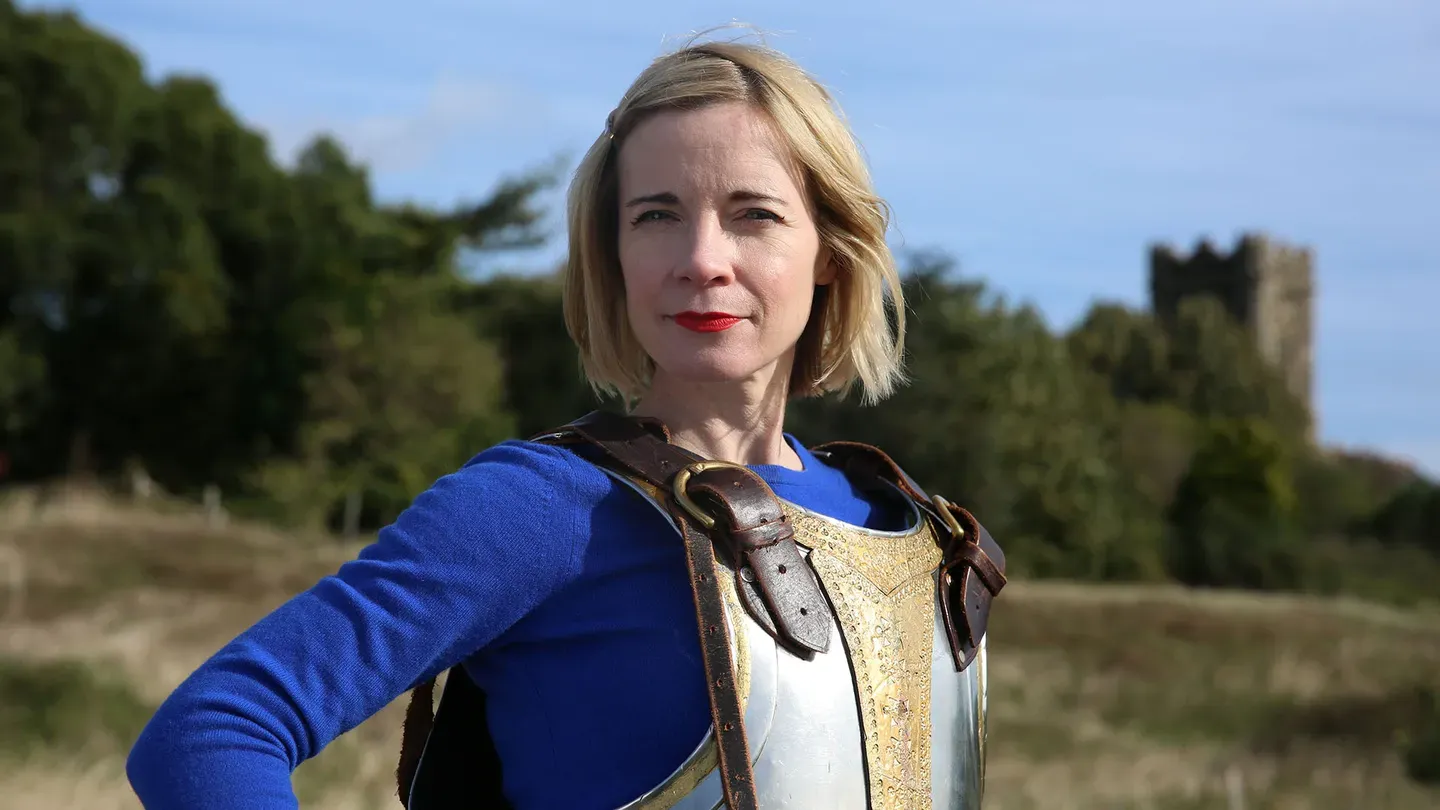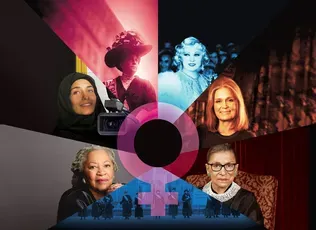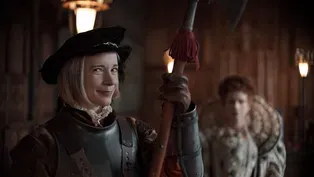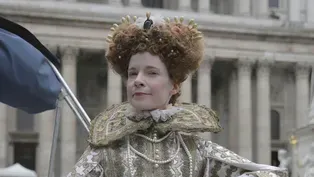

Elizabeth I: The Warrior Queen
Episode 1 | 54m 4sVideo has Audio Description, Closed Captions
Explore how Elizabeth I’s iconic warrior image shaped British national identity.
Join Lucy Worsley for an exploration of how Elizabeth I’s image as a warrior queen, created by a series of myths and secrets about her victory over the Spanish Armada, shaped British national identity for centuries.
See all videos with Audio DescriptionAD
Elizabeth I: The Warrior Queen
Episode 1 | 54m 4sVideo has Audio Description, Closed Captions
Join Lucy Worsley for an exploration of how Elizabeth I’s image as a warrior queen, created by a series of myths and secrets about her victory over the Spanish Armada, shaped British national identity for centuries.
See all videos with Audio DescriptionADHow to Watch Lucy Worsley's Royal Myths & Secrets
Lucy Worsley's Royal Myths & Secrets is available to stream on pbs.org and the free PBS App, available on iPhone, Apple TV, Android TV, Android smartphones, Amazon Fire TV, Amazon Fire Tablet, Roku, Samsung Smart TV, and Vizio.
Buy Now
Providing Support for PBS.org
Learn Moreabout PBS online sponsorship-In the year 1558, a new queen came to the English throne... ...a young woman who refused to be dominated by male power.
-We do not need your master's embrace, sir.
-Awkward.
Against all the odds, she would become one of the world's most iconic monarchs.
Elizabeth I, the Virgin Queen.
Her defeat of a seemingly invincible Spanish invasion fleet transformed her into a ruthless warrior.
I have the heart and stomach of a king, and of a king of England too.
The defeat of the Spanish Armada is often talked about as the crowning achievement of Elizabeth I's golden age and a defining moment in English history.
But was Elizabeth's victory more cunning propaganda coup than military triumph?
This is fake news, isn't it?
-You know, you'd think people would see through it, but people believe what they want to believe.
-So, what's the inside story that Elizabeth tried to keep secret?
More than half of the men who'd fought were killed not by the Spanish, but by disease and starvation.
And how has the myth of Elizabeth I inspired Britain's national identity for generations?
-This is about showing the continuous link between a sort of golden age of British monarchy, of Elizabeth I, and Queen Victoria.
-When Thatcher put herself up onto a tank, she was doing exactly what Elizabeth I had done.
-I myself will take up arms.
I myself will be your general.
♪♪ ♪♪ -The year is 1558.
In a time of bitter and often bloody religious conflict, England faced a crisis.
The nation's Queen was the Catholic Mary I, daughter of Henry VIII and Catherine of Aragon.
Mary was married to King Philip of Spain, also Catholic, giving Philip considerable political influence over England.
♪♪ But this royal power couple had failed to produce an heir and England's religious future was in doubt.
Next in line to the throne was Elizabeth, the Protestant daughter of Henry VIII's second wife, Anne Boleyn.
The chief rival was her Catholic cousin, Mary, Queen of Scots.
And Mary Tudor hated the idea of her half-sister ever becoming Queen.
♪♪ One of the ambassadors to court recorded that Mary's opinion of Elizabeth was that she was illegitimate, the daughter of a strumpet.
Mary wasn't a fan.
She doubted her half-sister's loyalty to herself as queen and also to the Catholic faith.
Mary thought that Elizabeth was involved in all sorts of plots against her.
She even had her locked up for a while in the Tower of London.
But Mary's Spanish husband, Philip, he had a different opinion.
The truth is Philip was on Elizabeth's side.
He even persuaded Mary to free her from house arrest, because the Catholic alternative, Mary, Queen of Scots, would've brought England under the control of Philip's enemies, the French.
-There was no way, for political reasons, that Philip could allow Mary, Queen of Scots to become Queen of England, because Mary was betrothed to the son of the King of France, and England would have been absorbed into the French Empire had Mary, Queen of Scots become Queen of England.
-So, there's lots of things wrong with Elizabeth, she's got this dangerous Protestant tendency, she's illegitimate in the eyes of his wife, but she's the least bad alternative, as far as Philip's concerned.
-Yes, and also he was convinced that he could turn her, you know, if she was -- -Into a good Catholic?
-Into a good Catholic.
Elizabeth, you know, she appeared to be submissive, she attended Catholic church services, including the mass.
Had she the right husband, she would conform, or at least keep the church where it was.
-The young Princess Elizabeth may have been the last person Mary Tudor wanted to see as Queen, but in the end, Mary relented to her husband Philip's demands and reluctantly declared her Protestant half-sister successor to England's crown.
Mary died in 1558.
In a bid to retain his influence over England, Philip sent his ambassador to remind Elizabeth just how much he'd supported her.
The Spanish Ambassador sent to woo young Elizabeth was the Count of Feria.
His mission?
To secure Spain's influence over England by convincing the new queen that she needs Philip's protection.
It was Philip after all who got her released from the Tower of London.
Feria's first task was to persuade Elizabeth she should ditch the Protestant faith for the Catholic church.
-The Catholic faith, Your Majesty... embrace it.
Philip seeks your support.
Seeks to support you, ma'am.
Embrace Rome, and Philip will embrace you.
♪♪ -Elizabeth has granted Feria a private audience to make his pitch.
The only people present are her two ladies in waiting as chaperones.
Now, I think that Feria wants to exploit Elizabeth's vulnerability.
She's only 25 years old.
She's in a new position.
She might well be feeling in need of powerful friends.
But I also think that Feria has underestimated our Liz.
-We do not need your master's embrace, sir.
We are grateful to Philip for his hand in our release.
But the king of Spain does not make me a queen.
Nor does Rome.
My people do.
-Awkward.
Philip will soon raise the stakes by offering Elizabeth his hand in marriage, but she decides to keep him in the friend zone.
A few months later, Elizabeth hears that Philip has gone and got married to a French princess instead, and she makes a joke that's classic Queen Elizabeth I.
She said, "If he couldn't even wait a couple of months to see if he got the right answer from me, he can't have loved me all that much anyway."
♪♪ With Elizabeth as queen, England became a Protestant country, but initially, she remained on friendly terms with Catholic Spain.
Fast forward nearly 30 years, though, and that relationship had... deteriorated... so badly that Philip would amass an invasion force against England, a mighty fleet that would become known as the Spanish Armada.
Legend has it that when it came to the Armada, Catholic Spain started it, they were the aggressors, invading England just because it was Protestant.
But that's way too simplistic.
It was going to take more than religion to drive Philip into war.
By the 1550s, Elizabeth had never married.
To marry meant declaring a husband king of England.
That would see Elizabeth lose her power, and she was determined to hang onto it.
But while the Queen refused to be dominated by a man, she certainly made use of one to further England's interests.
Elizabeth sent the infamous buccaneer and sea dog Francis Drake on a series of daring expeditions that ultimately antagonized the Spanish.
♪♪ Philip had a global empire, and the Pope had given him a monopoly on trade routes to the Americas.
But in the third decade of Elizabeth's reign, she began protecting Protestant interests by challenging Philip's global domination.
Elizabeth encouraged English sailors, like Francis Drake, to plunder Spanish ships and ports in the new world.
Her coffers were soon filling up with Spanish gold.
In 1518, Drake returned from a lucrative circumnavigation of the globe.
Elizabeth rewarded him with a knighthood.
The knighting of Drake marked him out as a national treasure.
But not everybody was pleased.
To the Spanish, Drake was nothing more than a pirate -- Rargh!
-- a thief who'd stolen their gold.
Elizabeth couldn't afford an all-out war with Philip, but she was determined to curb Spanish power before it crushed Protestant Europe.
♪♪ England wasn't just damaging Spain's interests in the new world.
It was also goading Spain on its own doorstep in Europe.
In Philip's territory, in the Netherlands, the Protestant population was rebelling.
Elizabeth sent an army of over 6,000 troops, to help the Protestant revolt.
Elizabeth knew that this was a dangerous move, so she set about taking control of the story.
The Queen circulated a pamphlet across Europe, justifying her actions.
She claimed she wasn't attacking her brother and ally, Philip -- she was just defending her neighbors.
♪♪ Despite Elizabeth's attempts to spin the story, to Philip, she was clearly supporting rebellion against him.
♪♪ To make matters worse, English ships were now raiding ports on the Spanish coast.
Elizabeth had provoked Spain into action, and Philip's plans for the Armada began to take shape.
♪♪ Philip would now unleash Spain's imperial power.
To stop Elizabeth's games, he would have to invade England and depose her.
After two years of planning, the Spanish Armada finally set sail in May 1588.
♪♪ What happened next would be retold for centuries as a classic adventure story, casting Philip as the bullying would-be conqueror, Elizabeth as the bold heroine, and her recently knighted buccaneer Sir Francis Drake as the Queen's loyal sea dog.
Traditionally, the story begins with Drake playing a game of bowls in Plymouth, a naval port on England's south coast, when the sails of the mighty Spanish Armada are first spotted on the horizon.
Francis Drake is the embodiment of cool Britannia [Chuckles] of "keep calm and carry on."
He turned to Lord Howard, commander of the English fleet, and he said, "We've plenty of time to finish our game and to thrash the Spaniards too."
It's classic English understatement.
It's nonchalance under fire.
Unfortunately, though, it's likely to be a complete fabrication.
Not one of the first accounts of the Armada mentioned anyone playing bowls.
So, where does it come from?
25 years after the event, we finally get a historical document which mentions the sailors at Plymouth dancing, bowling, and making merry on the shore.
Nearly 150 years after that, local legends about Drake finishing his game entered the history books, and by 1888, at the height of empire, his line about thrashing the Spanish was in print too.
Drake had become the perfect imperial hero, to inspire future generations with his stiff upper lip.
In the usual story of the Spanish Armada, it's gone down as invincible -- the largest fleet ever to sail on England.
Basically, the Armada is Goliath.
♪♪ Eyoo!
Meanwhile, England is the plucky little underdog fighting a cruel giant, determined to make the streets of London run with blood.
But that image is something of an exaggeration.
This wasn't the biggest fleet ever to attack England.
Bigger invasion fleets had been sent by the Normans in 1066 and by the French in 1545.
The Spanish fleet had around 130 ships.
The Queen's navy was only 34 ships strong, but a host of private ships were commandeered, to create a force which outnumbered the Spanish.
And before they even left home, the Spanish navy was in trouble.
♪♪ On paper, Philip of Spain had every right to be confident.
His armada might not have been the largest invasion fleet to assail England, but it certainly seemed pretty formidable.
Urgent message for the King.
However, Philip appears not to have been told that some of the ships were damaged, some of the sailors had diseases, and some of the fleet's provisions had gone rotten.
But he's about to find out.
The letter is from the commander of the King's Armada, the Duke of Medina-Sidonia.
And the Duke is writing with bad news.
The fleet has only got as far as the northern coast of Spain, and on top of that, the Duke says, the sailors have been completely useless.
Philip is going to write back, saying, "Pull yourself together, man, and get on with it."
In the meantime, all King Philip can do is pray.
♪♪ The Armada's aim was to sail in tight formation up the Channel towards its narrowest point.
There, they would meet an army of 26,000 soldiers from the Netherlands.
The Armada would protect this army as it crossed to invade England.
♪♪ As the Spanish made their way along the Channel, they were hounded by the English navy.
But the first two major casualties to the Armada were self-inflicted.
A crash within the Spanish fleet allowed Francis Drake to capture one of the damaged ships -- The Rosario.
But this disease-ridden, accident-prone Armada would soon be spun into the Goliath of history.
Because the fighting was all happening out at sea, communication was a real problem.
And this led to rumor and speculation and sometimes even outright lies.
The capture of the Rosario gave the popular press the most wonderful story to exploit.
During Elizabeth's reign, poets and playwrights had become powerful agents of pro-English propaganda, but one art form sent a message to the masses in the streets and taverns more effectively than any other -- the ballad.
-♪ Cost and pains ♪ ♪ But little land be not dismayed at all ♪ ♪ The Lord no doubt is on our side ♪ ♪ And soon will work therefore ♪ -Political songs were big sellers in this period, and these Armada ballads are that sort of political news and political commentary as well.
In this case, the words are by a man called Thomas Deloney, who was probably the greatest songwriter of his age.
He's like a, you know, Elton John, Lennon, Lennon-McCartney.
He knew how to kind of lay down a hit, like nobody else.
-Within a few days of the capture of the Rosario, Thomas Deloney had written a ballad about it.
-♪ With mighty power ♪ ♪ They come unto our coast ♪ ♪ To overrun our country quite ♪ ♪ They make their brags and boast ♪ -It seems like it's about current affairs, but if you actually look at the words [Laughs] this is fake news, isn't it?
It's not just news, it's fake news.
-Yes, definitely, but it is based on these actual events that happened, which are then sort of, you know, blown out of proportion.
The emphasis is very much on the might of the Spanish, the idea that, you know, that actually there's this huge force with massive ships, you know, massively armed, and plucky little England somehow survives.
♪ And to deflower our virgins in our sight ♪ ♪ And in the cradle cruelly the tender babe to smite ♪ -There's something about the language of it, we've got virgins being deflowered and babies being smited, that's very sort of tabloid, isn't it?
-Definitely.
I mean, it is a time of national panic, so to be told constantly "God is on your side," that you've had this miraculous escape, which just proves that whatever happens to you, you'll be okay, is reassuring.
♪♪ -Elizabeth's navy of commandeered ships stalked the Armada up the English Channel for eight days.
But as the Spanish reached Calais, there was still no sign of their 26,000 invasion troops with whom they were meant to rendezvous.
Now the Armada had to wait, exposed to attack.
♪♪ It's at this point in the story that Elizabeth's big moment comes.
And normally she's dressed to impress for it, perhaps in a white velvet gown, maybe with feathers in her hair, or even wearing armor.
The Queen visits her army here at Tilbury on the banks of the Thames, where they're assembled to protect Essex from invasion.
She delivers a rousing speech to the troops.
She says that she herself is here in the midst and heat of battle, "to live and die amongst you all."
"I know I have the body but of a weak and feeble woman, but I have the heart and stomach of a king and of a king of England, too.
I myself will take up arms.
I myself will be your general, judge, and rewarder of every one of your virtues in the field."
♪♪ In the traditional version of the story, the Queen's speech launches the attack.
The English set fire to eight of their own ships and sent them off into the midst of the Armada.
In a panic, Spanish ships cut anchor and were scattered.
Three collided and one ran aground.
In the battle that followed, four Spanish ships were lost.
Then strong winds drove the Armada to the north.
Cutting their losses, the Spanish headed home via Scotland and Ireland.
It seems like Elizabeth's rallying cry worked -- it did the trick.
But in fact, the story of her most famous speech is riddled with holes.
And the biggest fib of all lies in the timing.
When Elizabeth began planning her Tilbury visit, invasion did seem imminent.
But by the time she actually made the speech, the battle was over.
This extravaganza at Tilbury happened a whole 11 days after the fire ships.
And by this point, the Spanish Armada, well, it had floated off.
It was somewhere off the coast of Scotland.
Not only were the men not going to get to do any fighting, very soon they were going to get sent home, and that was because the Queen couldn't afford to go on paying their wages.
But that didn't fit with the image of Elizabeth that was already emerging, even as the Armada sailed home.
A poet called James Aske, who claimed to have been at Tilbury, wrote an epic verse called "Elizabeth Triumphans" in November 1588.
♪♪ It mythologized Elizabeth as a warrior queen, and it placed Tilbury before the battle, for dramatic effect.
But Aske doesn't mention the most famous line in her speech.
The reference to the heart and stomach of a king doesn't appear until 35 years after the event.
It was first introduced by a Protestant chaplain who'd also been at Tilbury, and who was keen to glorify the now long-dead Elizabeth.
Historians still argue over the speech's authenticity.
But, accurate or not, countless film and TV dramas have made the myth of Elizabeth's speech feel like it must have happened.
-...of a king, and a king of England too!
[ Cheering ] -As the Armada made its long journey back to Spain, at least 22 ships were sunk in storms off the coast of Scotland and Ireland.
It wasn't the Queen or her navy who had dealt the decisive blow to the Spanish Armada -- it was the weather.
But that suited the Elizabethan narrative very well.
If anyone still doubted that the future of England was Protestant, this victory would be used to put them right.
The storms which had scattered the Armada were God's storms, which meant that God had clearly picked the Protestant side.
And all over Europe, Protestants were determined to make a big deal about this.
Even Elizabeth herself wrote a verse praising the God who'd made the winds and waters rise to scatter all of her enemies.
In the Netherlands, celebratory medals were struck, like this one.
It says on it "He blew," that's God blew, and they were "dissipati," they were dissipated, they were scattered.
England was a unified, victorious, Protestant nation.
After the Armada, the Protestant propaganda war continued.
♪♪ A letter from a Catholic priest in England to the Spanish ambassador in Paris was published across Europe.
The person who wrote the letter found it highly regrettable that Spain had tried to invade England, and he claims that even English Catholics had thought that this was a bad idea, a mistake in the eyes of the Lord.
He even claims that these English Catholics are more loyal to their queen than they are to the pope.
The word he uses is "addicted."
He says they are addicted to her.
And some translations finish like this -- "Here ends the story of the misfortunes of the Spanish Armada, which they used to call invincible."
Invincible, ha-ha-ha.
It's even written in capital letters, just to heighten that delicious irony.
The description of the Armada as invincible still appears in history books today.
But it was never used by the Spanish to describe their Armada.
And it gets worse.
The letter was a fake.
It was a forgery.
It was made up by the Machiavellian William Cecil, Elizabeth's close advisor.
There are even drafts of it in his own handwriting.
But this was a brilliantly successful bit of fake news.
People believed it, and they thought, "Well, if even the English Catholics are keen on the Queen, then she must now truly rule over a unified nation."
♪♪ In November 1588, Queen Elizabeth I held a procession through London.
This was her victory parade.
The Queen made her way through the city to St Paul's to give thanks.
God and his chosen special monarch together had saved the day.
They were the hero and the heroine at the heart of this narrative.
But in reality, though, things weren't quite so heroic.
Elizabeth's promise at Tilbury to reward her soldiers proved to be empty rhetoric.
The war had drained Elizabeth's coffers.
The sailors who fought for England were hit by disease and were still fighting for their wages.
The crown threatened prison for those slanderously suggesting that they hadn't been paid.
William Cecil now rubbed salt into the wound.
He said, "Well, if the soldiers die of illness, then at least the crown won't have to pay them."
By the end of 1588, more than half of the men who'd fought in the Armada campaign were dead, and they were killed not by the Spanish, but by disease and starvation.
♪♪ The reality of post-Armada England was economic crisis and an increasingly unpopular Queen.
It was time for a royal makeover.
Elizabeth is now in her 50s, unmarried, and too old to produce the all-important heir to the throne.
Her lustrous red locks have gone.
Her face is pock-marked.
More than ever Elizabeth must conceal her frailties.
Elizabeth has to manufacture an image of eternal youth.
She needs to present herself as something more than merely mortal.
On goes the white lead makeup to cover her smallpox scars... and a red wig to cover up her grey hair.
♪♪ ♪♪ This is Elizabeth I as the Virgin Queen.
She's married, but only to her country, and this isn't just an image for her courtiers -- everyone in England will see this.
It's like a Tudor profile pic, and the handle is Gloriana.
♪♪ ♪♪ What we're seeing here is the creation of an Elizabethan marketing campaign.
Elizabeth had lots of different portraits of herself commissioned, and they were sent out across England, across Europe.
And all of them were loaded with propaganda messages.
They said that Queen Elizabeth I is pure, that she's powerful, that's she's going to make England great again.
♪♪ One of the most potent of all Elizabeth's portraits made specific reference to the Armada and to England's aspirations to build an empire.
-This portrait is absolutely overflowing with symbolism.
And indeed the pearls are probably the most prominent symbol in this picture.
It seems to be the sort of endless abundance of them.
Pearls at this period symbolized purity and chastity, and of course Elizabeth, at this point, in 1588, she's in her mid-50s, she's no longer of child-bearing age, and we see this cult of the Virgin Queen being introduced.
So, we have, for example, this fabulous pearl positioned exactly where, in a portrait of Henry VIII, you'd have an enormous codpiece, for example.
So this is Elizabeth really playing on this idea of her virginity and, of course, this is a mirror of the idea of the impenetrability of England.
-A Virgin Queen who'd failed to produce an heir was highly problematic.
But in the story of the Armada, Elizabeth's virginity becomes a superpower.
-This puts her front and center of the events unfolding, and it positions her, really, as the sort of grand choreographer of what's going on.
And she is, if you like, the source of light in this picture, and she is casting her light onto this scene in the left of the picture of the English fleet and turning her back, of course, on the Spanish fleet, which is wrecked in this storm.
-She's taking the credit for it all, really.
-Absolutely, yeah.
Absolutely.
-Good for her.
[ Chuckles ] She owns it.
-[ Laughs ] -And what has she got under her hands, there?
-This hand is hovering over a globe, and you can just about make out her fingers are almost caressing, if you like, an image of the Americas.
This is a not-so-subtle reference to her and England's ambitions for empire.
But, indeed, when she died, there was no empire to be spoken of beyond the British Isles.
This is really an image of aspiration and not of reality.
-The British Empire starts here.
-Indeed.
-In the grasp of those white fingers.
-Indeed, yeah.
This is the sort of creation myth, if you like, this idea of Britain as an island nation that is looking globally with its ambitions across the Atlantic.
-This is just an amazingly powerful propaganda message, isn't it?
And wouldn't you say it's really worked terrifically well?
-It is the victors who write history, of course, so this is a classic case of that.
-And the painters who paint history as well.
-Indeed.
-They did a very good job in selling her version.
But Elizabeth's version of history hid a brutal truth.
The Queen might be able to spin Philip's disastrous attempt to dethrone her into an English victory, but secretly she was a long way off winning the war with Spain.
Peace and unity come to England as the Spanish ships are broken by the storm.
But that's just another big fib, 'cause it's not the end of the story of the Spanish Armada.
By the end of 1588, Elizabethan England was planning a Counter Armada.
The war with Spain was unfinished business.
Around half of Philip's ships had made it home and were now being repaired.
So, in 1589, Sir Francis Drake led an attack on Spain.
His orders were to destroy what was left of Spain's fleet, invade Spanish-owned Portugal, and put a Portuguese king on the throne.
But the expedition failed.
England's Counter Armada was a disaster.
Today, English people have forgotten the story of the Counter Armada.
Was it well-known at the time, in the 16th Century?
The pamphlets downplayed the failure and denounced negative accounts of the expedition as malicious slander.
Our propaganda was better, yes?
-Yeah, of course, yeah.
-So, we English people, we like to think that England beat Spain.
[ Chuckles ] We won!
But it's not that simple, is it?
But as the war with Spain dragged on, no amount of propaganda could hide the mounting cost of the conflict, and Elizabeth's popularity began to fade.
Yet a cult of reverence had built up around her.
One ambassador remarked that in old age she was "graceful" and "kept her dignity," and she remained charismatic enough to deliver a rousing speech when needed.
In the end, Elizabeth was queen for an extraordinary 44 years, at that time, the third longest reigning monarch England had ever known.
♪♪ In 1603, the Tudor dynasty came to an end with Elizabeth's death.
The crowns of England and Scotland were united, as James VI of Scotland became James I of England.
But with Elizabeth's death, the cult of the Warrior Queen began to exert an even greater influence over national identity, and a new generation looked to her and to the events of her reign to weave a powerful myth about the origins of Britain's Imperial might.
The heroic Queen strand of the Armada tale continued to dominate in the 17th Century.
But now it wasn't just Elizabeth being mythologized.
With all this talk about a Protestant wind and a royal victory, the contribution that the navy made to the defeat of the Spanish Armada seemed to be taking second place.
But the commander of the fleet, Lord Howard of Effingham, he saw things differently.
In 1592, Lord Howard commissioned one of Europe's greatest weavers to create 10 tapestries for his London home.
Based on his own account of the campaign, they cost over £1,500, the equivalent of 87 years' wages for the average English worker at the time.
These tapestries told the naval story of the Armada on a gigantic scale.
They were four meters tall, some of them were nine meters wide.
They must've looked absolutely massive in Howard's house.
But they were going to make an even bigger impact than that.
In 1616, Howard sold his tapestries to King James.
And they were hung at the heart of political power -- in the House of Lords.
By the late 18th century, the tapestries had become an integral part of Westminster.
Not only were they a reminder of the great historical event, they were also being used as propaganda in their own right.
In 1798, Britain was threatened by another European invasion, this time from Napoleonic France.
To inspire patriotism, satirist James Gillray created a series of cartoons called "Consequences of a Successful French Invasion."
Gillray shows French revolutionaries who've invaded England tearing down the Armada tapestries.
This one is hacking at them with his sword, this one is setting fire to them.
And here are the familiar words about the defeat of the Spanish invincible Armada.
England's great triumph over a European enemy is really what's being torn down here.
And with it, one of the founding mythologies of England's national story.
In 1834, Gillray's vision of burning tapestries became a reality.
A fire swept through Westminster and they were destroyed.
But a plan soon emerged to recreate the tapestries as paintings for the new Victorian Palace of Westminster.
Here the Victorians created a space to showcase, not just the Armada victory, but the whole "Golden Age" of Elizabeth's reigning Tudor dynasty.
Whose artistic vision do we see here, in this really rich gold-encrusted interior?
-Well, the Fine Arts Commission were tasked with decorating the entire palace, but it was Prince Albert, as the chair of the commission, who really drove the direction of the artistic works that we see here.
This room was selected to be a Tudor room.
So, the scenes that you see around the room are various scenes from Tudor history.
These are then topped with a series of Tudor portraits, and then all of this is topped off with the views of the Armada.
And at the center of the entire room, we have this enormous statue of Queen Victoria herself, by Gibson.
-It's pretty Tudor-tastic in here.
-It certainly is.
-I think it's very telling, 'cause there's been, you know, a lot of British history that was available to them to revive, but no, they went for the Tudor age.
That seemed like the most potent, the most exciting age for them to associate themselves with.
-Well, the Armada's seen as the most important British naval victory in history, and so by highlighting a link to that, it's showing the enormous naval power of Britain in the Victorian age.
-She thought, "I'd like a little bit of that glory to rub off on me."
-Absolutely.
I mean, having Victoria's enormous statue in this space is drawing a very clear line between Victoria herself and all of her Tudor forbears.
This is about showing the continuous link between a sort of golden age of British monarchy, of Elizabeth I, and the relatively, at this point, relatively new Queen Victoria.
♪♪ -For the Victorians, the Golden Age of Elizabeth's reign and her Armada victory signaled the start of the British Empire.
In the 19th Century, Britannia ruled the waves, and heroic tales about the Armada seemed to offer a connection to England's past.
This story of British sea power began with Drake's game of bowls and led to this massive empire.
The Victorians pushed the naval triumph back into the national consciousness.
Monuments and art celebrated Sir Francis Drake.
And Elizabethan sea dogs became the heroes of popular fiction.
As the Empire flourished, the Armada victory became a tale of British naval power and courage.
And Elizabeth I?
To the Victorians, she was the iconic mother figure of an English "Golden Age" who oversaw the origin story of Empire and national identity, and that version of the story survived, even as the British Empire eventually crumbled.
Nearly 400 years after the defeat of the Armada, another female leader would be inspired by Elizabeth the Warrior Queen.
-I know there are one or two men of prejudice, but after all, their prejudice is really so, so ridiculous.
I mean, I say to some of them sometimes, "My goodness, it's as well you didn't live in the time of Queen Elizabeth I, isn't it?"
After all, I wonder if we should've grown to such a fantastic nation if we hadn't had people like her.
-In January 1976, Margaret Thatcher gave a speech called "Britain Awake."
It was a call to arms for Britain to stand up to communism and Russian aggression.
Now, in response to the speech, a Soviet newspaper, the Red Star, came up with a nickname for Margaret Thatcher.
It was The Iron Lady.
She was quick to respond to this, and a week later she made another speech defending herself with what seems to be an allusion to Elizabeth I.
-I stand before you tonight in my red star chiffon evening gown.
[ Laughter and applause] ♪♪ My face softly made up and my fair hair gently waved.
[ Laughter ] The Iron Lady of the Western World.
[ Laughter and applause ] -She too had a feminine exterior hiding the heart and stomach of a king.
-They're welcome to call me what they like, if they believe that we should ignore the build-up of Russian military strength.
-The Iron Lady moniker would stick, and so too would the image of Thatcher as warrior leader, at the center of the action amongst her troops.
Jenni, how does it seem to you that Margaret Thatcher used the idea of Elizabeth I in her self-presentation?
-Elizabeth I was a phenomenal person for putting herself forward, knowing how to dress, knowing how to behave, knowing how to speak, knowing how to be feminine and war-like.
And when Thatcher put herself up onto a tank, she was doing exactly what Elizabeth I had done at Tilbury.
Whenever I drive past Tilbury, a little thrill goes through me, and has done since I was a teenager, and I learned about Elizabeth I on her white charger, delivering that amazing speech that, you know, she had the body of a weak and feeble woman, but the heart and stomach of a king.
And I remember thinking as a teenager, "Wow, that is amazing."
And then when I looked at Thatcher, I thought, "She has exactly that same sense of femininity and having to play on her femininity to quite a degree."
Whether Thatcher thought, "Mm, maybe I could be like Elizabeth I," I don't know, but when Elizabeth sat on that charger and made her wonderful speech, you can draw a direct line to Thatcher sitting on a tank.
-Elizabeth's Tilbury visit has become a touchstone of history, but it's a touchstone built on shaky foundations.
Now, the Tilbury speech that everybody loves, does it not matter to you that it didn't really quite happen in that way that we like to think that it did?
-I know it's questionable, but I will not question it.
That image of a woman being powerful and taking control and being proud of her power and knowing how to express it is a myth that -- I don't believe it's a myth.
I think it's true.
-So, even if it's a myth, it's a good myth for us to have around?
-It's a very good myth.
[ Laughs ] -Yeah.
[ Laughs ] "Take that, history!"
-Quite.
-Margaret Thatcher understood the power of the Armada legend, and even after she left office, she continued to use Elizabethan history for her own purposes.
In 1998, the Chilean dictator General Pinochet was held under house arrest in England.
Spain wanted to extradite him to face trial for human rights crimes.
Margaret Thatcher took on the Spanish and campaigned for his release.
When Pinochet was declared unfit to stand trial and sent home, his plane was stopped on the runway to take delivery of a gift from Margaret Thatcher.
It was a plate commemorating the defeat of the Spanish Armada.
It came with a personal note from Thatcher.
"With your return to Chile," she wrote, "Spain's attempt at judicial colonialism has been decisively and, I trust, permanently rebuffed."
Now, we don't know what Pinochet made of his plate, but we do know that the Spanish weren't impressed by all this.
Their foreign minister said that Thatcher needed her head examining.
And so the story of the Spanish Armada has a powerful legacy, but would the myth be so enduring if it weren't for the inspiring Warrior Queen at its heart?
Surely, it's Elizabeth's story that makes it feel special.
It's been used to convince us that our little island can take on superpowers, that we come from a line of cool-headed and inspirational leaders, that, small as we are, we can still play a mighty role on the world stage.
Even in a secular age, it seems like English people, British people, feel special, marked out for greatness.
And whether it's true or not, the drama of that defeat of the Armada gives us the confidence to believe in ourselves.
Who knows where that potent mix of fact and fantasy and fibs may take us next?
♪♪ -Next time, the inside story of forgotten Queen Anne of England, whose legacy was destroyed by salacious gossip about her love life.
-Besides the church, she dearly loved a dirty chambermaid.
-But was she really the secret mother figure of a global power?
The nation that became Great Britain.
-She was exactly the queen that England, and then later Great Britain, needed.
Episode 1 Preview | Elizabeth I: The Warrior Queen
Video has Closed Captions
Explore how Elizabeth I’s iconic warrior image shaped British national identity. (30s)
Queen Elizabeth I's Encounter with the Count of Feria
Video has Closed Captions
In 1558 King Philip of Spain sends an ambassador to woo young Queen Elizabeth. (2m 46s)
Queen Elizabeth I's Speech at Tilbury
Video has Closed Captions
Lucy takes us to Tilbury where Queen Elizabeth delivered her most famous speech to troops. (3m)
Video has Closed Captions
We see Lucy as Queen Elizabeth I on her victory procession through the streets of London. (3m 12s)
Video has Closed Captions
Lucy tells us how Elizabeth’s actions provoked Spain into setting sail to invade England. (3m 6s)
Providing Support for PBS.org
Learn Moreabout PBS online sponsorship
















